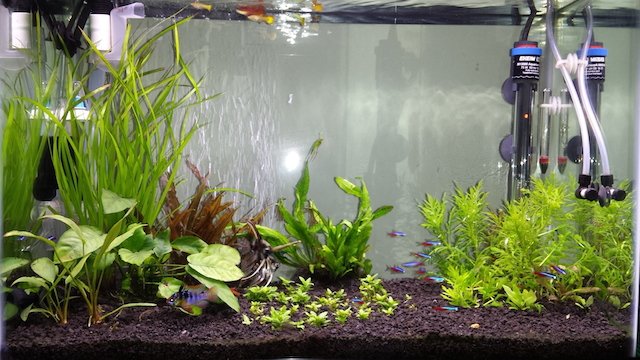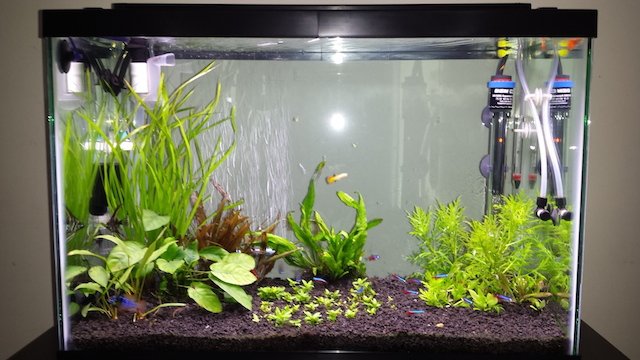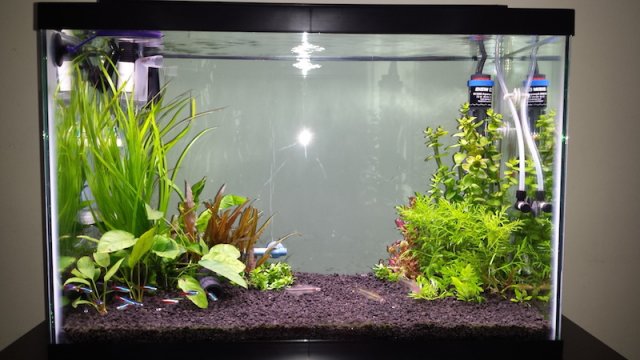Hi
I have a 20G high freshwater tank with Live plants, I recently switched to Fluval P24 AQUALIFE & PLANT FULL SPECTRUM from Duel T5HO.
I had good plant growth, but now switching to the Fluval P24. Does anyone have any experience with planted tank with this product.
Lighting :
Before : AquaticLife Duel-Lamp T5 Ho fixture with Giesemann PowerChrome AquaFlora 24" 24W HO T5 Lamp & PowerChrome 6000K Midday 24" 24W HO T5 Lamp - on timer 8hrs/day
Now : Fluval P24 AQUALIFE & PLANT FULL SPECTRUM on Timer 8 hrs
Tank : 20G High
Substrate : CaribSea - Eco Complete Planted Black Aquarium Substrate & Seachem Flourite BlackFilter : Fluval 206 Canister filter.- Full time
UV - Corellife Turbo Twist - On timer - 4hrs/day
CO2 : Pressurized CO2 (GL - ATOMIC CO2 REGULATOR V2) On timer
2 X Timer GE 15 Amp 7-Day Plug-In Dual-Outlet Digital Timer - 16$ Homedepot/Walmart. (Best timer than any sold in Aquarium Shop)
Aeration - on Timer 8 hrs/Day
Timer setup
1. Timer - 8hrs/Day - Light,CO2 & Aeration
2. Timer - 4hrs/Day - UV
Plants:
Cyperus Helferi
Anubias, Coffeefolia (Anubias barteri v. Coffeefolia)
Aeterophylla (Anubias heterphylla)
Staurogyne repens
Hygrophila Pinnatifida
water wisteria
Fishes
1 x German Blue Ram
6 x Neon
2 x small angels
2 x Mexican Dwarf Orange Crayfish
1 x chines algae eater
4 x Guppies


My worry is, if the plants will grow good with this LED Fixture.


I have a 20G high freshwater tank with Live plants, I recently switched to Fluval P24 AQUALIFE & PLANT FULL SPECTRUM from Duel T5HO.
I had good plant growth, but now switching to the Fluval P24. Does anyone have any experience with planted tank with this product.
Lighting :
Before : AquaticLife Duel-Lamp T5 Ho fixture with Giesemann PowerChrome AquaFlora 24" 24W HO T5 Lamp & PowerChrome 6000K Midday 24" 24W HO T5 Lamp - on timer 8hrs/day
Now : Fluval P24 AQUALIFE & PLANT FULL SPECTRUM on Timer 8 hrs
Tank : 20G High
Substrate : CaribSea - Eco Complete Planted Black Aquarium Substrate & Seachem Flourite BlackFilter : Fluval 206 Canister filter.- Full time
UV - Corellife Turbo Twist - On timer - 4hrs/day
CO2 : Pressurized CO2 (GL - ATOMIC CO2 REGULATOR V2) On timer
2 X Timer GE 15 Amp 7-Day Plug-In Dual-Outlet Digital Timer - 16$ Homedepot/Walmart. (Best timer than any sold in Aquarium Shop)
Aeration - on Timer 8 hrs/Day
Timer setup
1. Timer - 8hrs/Day - Light,CO2 & Aeration
2. Timer - 4hrs/Day - UV
Plants:
Cyperus Helferi
Anubias, Coffeefolia (Anubias barteri v. Coffeefolia)
Aeterophylla (Anubias heterphylla)
Staurogyne repens
Hygrophila Pinnatifida
water wisteria
Fishes
1 x German Blue Ram
6 x Neon
2 x small angels
2 x Mexican Dwarf Orange Crayfish
1 x chines algae eater
4 x Guppies


My worry is, if the plants will grow good with this LED Fixture.





